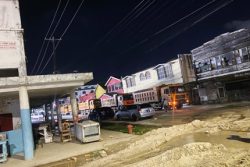 I recall that long before a year had elapsed of Mrs Janet Jagan’s presidency, an outcry arose regarding her failure to hold a press conference. She eventually held one about one year into her presidency. The voices calling out Mrs Jagan in 1997-8 are still around, but have gone silent on President David Granger’s failure to hold a single press conference despite having been elected to office one-and-a-half years ago. The Norconsult Report on the Amaila Falls Hydropower Project (AFHP) is only one of the major issues of great importance facing the country and a serious and coherent response is yet to be had from the government.
I recall that long before a year had elapsed of Mrs Janet Jagan’s presidency, an outcry arose regarding her failure to hold a press conference. She eventually held one about one year into her presidency. The voices calling out Mrs Jagan in 1997-8 are still around, but have gone silent on President David Granger’s failure to hold a single press conference despite having been elected to office one-and-a-half years ago. The Norconsult Report on the Amaila Falls Hydropower Project (AFHP) is only one of the major issues of great importance facing the country and a serious and coherent response is yet to be had from the government.
When the Norconsult Report was commissioned the clear indication was that the government would abide by its conclusions. In announcing the report in November 2015, Minister Winston Jordan said that, “Norway seems keen to finance an independent review to, once and for all, pronounce on the viability of the project.”
The Report pronounced in favour of AFHP. It stated: “The only realistic path for Guyana towards an emission free electricity sector is by developing its hydropower potential.
The fastest way forward is to maintain AFHP as the first major step for substituting its current oil fired generation … Compared to its domestic power demand, Guyana has large untapped sources of hydropower. Switching the bulk of its power generation to hydropower would be an effective main strategy, and probably the only realistic one, for transition of its power sector towards emission free generation.”
The Report reviewed several critical areas of the AFHP including its adequacy, environmental impact, engineering and financing. In each area it advanced solutions to problems and future challenges that it uncovered. These and other issues were heatedly debated in Guyana while APNU and AFC were in opposition as well as by independent observers, such as Mr Christopher Ram.
In relation to adequacy the Report states: “Amaila Falls alone cannot provide a 100% emission free power generation in Guyana. Other generating sources will have to be added in parallel like sun, wind and thermal production based on emission neutral fuel (bagasse) for back-up in the dry periods when the water flow to AFHP may be insufficient for full capacity operation. As the power demand is growing, and for reaching the goal of 100% emission free generation by 2025, as assumed by the LCDS (Low Carbon Development Strategy), a second hydropower plant of capacity comparable with AFHP will have to be commissioned by 2025. In parallel with preparations for AFHP, therefore, pre-feasibility studies will have to be carried out for promising candidates for the second hydropower project and a full feasibility study (would have to) be performed for the selected candidate.” Clearly the Report envisages that sun, wind and thermal power have important but junior roles to play in supplying power and even with these, an additional facility will be required on which, it recommends, prefeasibility studies should be carried out.
In relation to the financing the Report advises: “By restructuring the financial model, the risk for Guyana’s economy can be reduced. The annual payments from GPL may possibly be reduced by 20%, which are significantly lower than the current fuel costs paid by GPL for its oil fuelled generation. The risk to Guyana’s economic stability would be at the same level with other projects generating the same amount of energy, as the investment would be of a similar magnitude”.
The Report was greeted negatively. One statement falsified the conclusions. It said: “It is the view of the Government that the Norconsult … provides supporting evidence that the Amaila Falls Hydropower Project would not be optimal in its current model and presents an unbalanced risk to the Government and People of Guyana.” This obvious falsehood was later corrected by Minister Patterson but still, his comments obfuscated the purpose for the Report and contradicted the explanation given by Minister Jordan. The Stabroek News of January 5 reported: “He [Minister Patterson] said that the reason behind Norconsult doing the report did not stem from the feasibility of the AFHP and that “no one is questioning the viability of the project at Amaila…The question of Norconsult was a question of what happens to the US$80M which the people of Guyana would’ve earned (from the forest protection deal with Norway)….” Even if the question was “what happens to the $US80 million which the people of Guyana would have earned,” the Report answered it – put the money in the AFHP.
Guyana’s hydropower potential has been recognized since the 1960s when the then PPP government unsuccessfully sought funds to construct two small hydropower facilities. During the 1970s-80s the then PNC government went to great lengths to obtain funding for the US$300 million Mazaruni hydropower plant and to prepare the groundwork for it. Earlier, in the mid-1970s, the Guyana Electric Company (GEC) collapsed due to lack of maintenance and more than 40 years later, GPL has not been adequately upgraded to supply the electricity Guyana needs at competitive cost to households, much less to industrialize. Does anyone seriously expect that the alternatives, sun, wind and thermal power, being pushed by the government, will do the job that AFHP and a second facility will?
This issue is fundamental to the future of Guyana. A newspaper debate followed by a statement of the government’s decision are inadequate. The President should host a press conference to clarify government’s contradictory positions and a full parliamentary debate ought to take place – before a decision is taken. We must not postpone Guyana’s potential industrialization for yet another generation.








